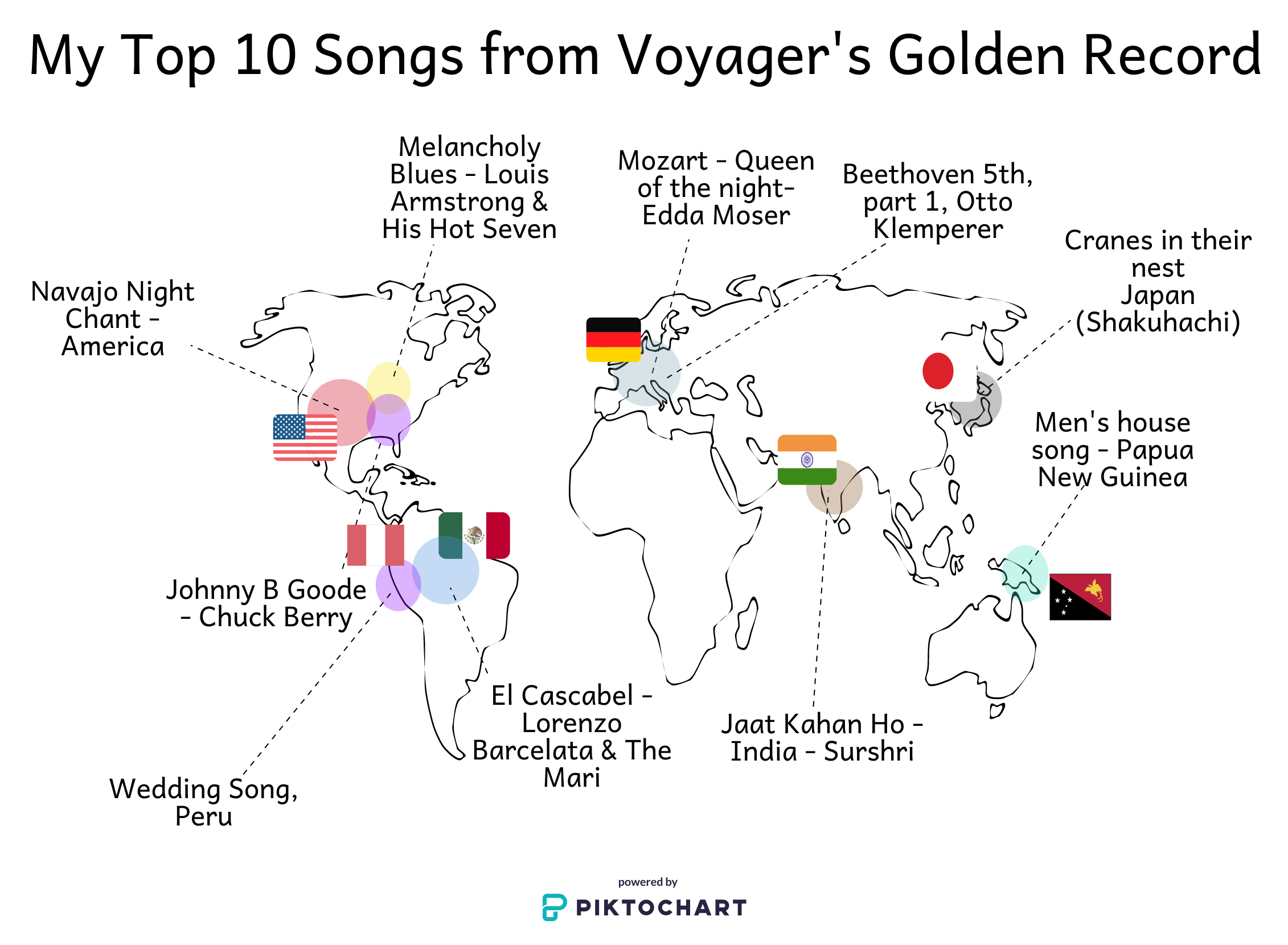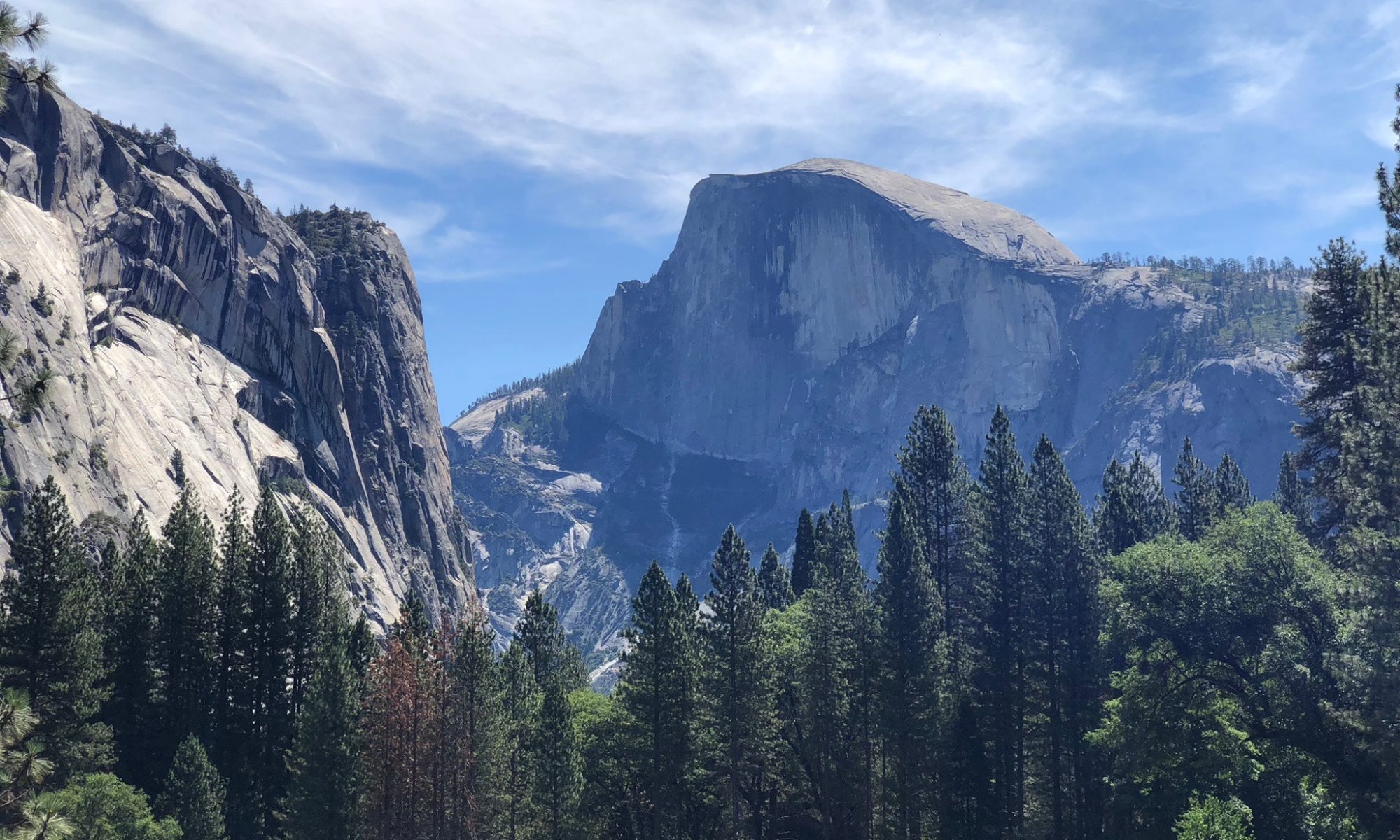This task challenged me to select 10 songs from the 27 that are on the Voyager record that was launched in 1977. For this process I decided to listen to all of the songs on the track, followed by a second listening where I wrote down the tracks I thought should be included. I then narrowed down my initial list by searching up some meanings and locations of the tracks. The tracks I wanted to include are songs that reflect humans values and diversity, incorporating voices from both men and women and from places around the world. I also wanted to have a balance of tracks that feature human voices and musical instruments. I noticed that mens voices are more prevalent on this track as well as songs from the United States. I create an image to visualize the tracks I selected on a world map.

The tracks are not listed in any particular order.
- Peru, wedding song, recorded by John Cohen. 0:38
- Mozart, The Magic Flute, Queen of the Night aria, no. 14. Edda Moser, soprano. Bavarian State Opera, Munich, Wolfgang Sawallisch, conductor. 2:55
- Navajo Indians, Night Chant, recorded by Willard Rhodes. 0:57
- “Melancholy Blues,” performed by Louis Armstrong and His Hot Seven. 3:05
- “Johnny B. Goode,” written and performed by Chuck Berry. 2:38
- India, raga, “Jaat Kahan Ho,” sung by Surshri Kesar Bai Kerkar. 3:30
- Mexico, “El Cascabel,” performed by Lorenzo Barcelata and the Mariachi México. 3:14
- Tchenhoukoumen, Senegal, percussion, recorded by Charles Duvelle. 2:08
- Beethoven, Fifth Symphony, First Movement, the Philharmonia Orchestra, Otto Klemperer, conductor. 7:20
- Japan, shakuhachi, “Tsuru No Sugomori” (“Crane’s Nest,”) performed by Goro Yamaguchi. 4:51
|
Track |
Reasoning |
| Wedding Song, Peru | This song features a female voice with no instrumentals or instruments. It is unique to the record because it is a celebration of marriage and represents South American culture. |
| Mozart, The Magic Flute, Queen of the Night aria, no. 14. Edda Moser | This is one of the only songs featuring a female voice and musical instruments and I feel this song is very familiar to many people. This song is a great representation of classical music.
|
| Navajo Indians, Night Chant | This track features both men and women who are native to America. The chant represents a healing ritual and demonstrates the unique sounds that humans can produce with their voices.
|
| Melancholy Blues, Louis Armstrong and His Hot Seven | This song represents the range of brass instruments and drums that we have on Earth and is an example of Jazz music. |
| Johnny B. Goode, Chuck Berry | This track should be included on the record because it is an example of Rock n’ Roll music that is upbeat and encourages me to dance around. I could only assume it has the same influence on any life out in space. |
| Jaat Kahan Ho, sung by Surshri Kesar Bai Kerkar. | This song features a female Indian vocalist. The song title in English is “Where are you going along, girl” which I think is fitting for a track that is going out into space, where is it going? |
| El Cascabel, performed by Lorenzo Barcelata and the Mariachi México. | This song is a Mexican folk song that features male voices. It is upbeat and also features guitar like instruments. |
| Tchenhoukoumen, Senegal | This track includes many different types of percussion instruments that are not included in other tracks. It is a playful track that has an upbeat tempo. |
| Beethoven, Fifth Symphony, First Movement, | This song is another example of classical music; however I think it should also be included because it is a very familiar song that includes many string instruments and is only instrumental, compared to The Magic Flute which includes vocals as well. |
| Tsuru No Sugomori, Japan, shakuhachi | This song should be included because I think its sounds are very reflective of nature sounds on Earth. This may give insight to other lifeforms that we have nature. |

Hi Katlyn,
We took a very similar approach to this task! I also wanted to include tracks from across the globe, and felt it was important to include female voices. I don’t have a musical background, so I really focussed on my emotional response to the songs. I started thinking about how this task had some similarities to this week’s discussion about those trying to decide what to digitize…so difficult to decide what to include and what to leave behind!
Hi Helen,
I agree, all the songs are great in their own way. It really comes down to personal preference. When writing my post for task 9 and reasons why a song wasn’t selected it is really difficult to say. There are sooo many songs out there that the 17 songs that weren’t selected are still really great.
Hi Katlyn,
Thanks for including the map! You’ve used a lot of different ways to curate a diverse collection. I curious as to why there is no songs from the Eastern Europe/ Northern Asia (Russia)? Also, I can appreciate the title “Jaat Kahan Ho” being fitting for the voyage into space. This was one of my least favourite tracks but after reading the meaning and a bit about the artist, I had to add it Plus it is the only “raga” and song from India.
Hi Rebecca,
I’m sure there is so much to learn about the meaning of these songs that I just didn’t get into. The more I read about the meaning of the songs the more difficult it was to select!
Hi Katlyn,
It is really difficult to come up with a ‘right’ way to curate the songs. I had difficulty trying to make judgements about cultural representation and diversity. I know these songs were largely selected by white American men, who may or may not (probably not) sought much input from diverse cultures and peoples around the world. The diversity in the original golden record is diversity through a very specific lens. The songs are also musical selections that the original group deciding on their inclusion liked musically – another very difficult criterion to use, as you and Rebecca have noted above. A song might be a great representation of a certain people, place, and time, but we might really dislike it musically. I think all of our efforts to be diverse and inclusive are good, noble, and worthwhile, without actual input from diverse groups, I find the process inherently flawed.
I agree with what appears to be your biggest struggle, however, that 10 is just not enough to represent our world!